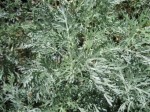 I am inordinately attracted to plants with silver-gray foliage and I am in love with Artemisia ‘Powis Castle’. The finely divided foliage is exquisite and provides a lovely contrast to coarser plants like garden phlox and balloon flowers. The color is spectacular with pink beebalm or blue salvia, but looks good with just about any color in the garden, taming down the harsh flashy ones and enhancing the subtle colored ones. In fact, it even looks good alone when the other perennials have become dormant. Add ‘Powis Castle’ to a drab area and it will brighten it and add softness and refinement. It forms a well shaped mound about 2-3 feet high in spring but sometimes gets a little frisky by summer and I have to cut it back a little to keep it in its place. Mine has never bloomed although I have read that some do. No problem if it does bloom, the flowers are small and I can easily cut them off. Neither the rabbits nor deer have bothered my artemisia probably because of the medicinal scent of the foliage that I rather enjoy when I work around it. I grow it with perennials and annuals in the border of a formal garden but it can also makes a good container plant. Although it really likes dry lean soil it tolerates my fertile soil and overhead irrigation with great grace, at least so far, but I know from past experience that an artemesia can die without warming. The generic name, Artemesia, is the name of the Greek goddess of chastity, the hunt, and the moon.
I am inordinately attracted to plants with silver-gray foliage and I am in love with Artemisia ‘Powis Castle’. The finely divided foliage is exquisite and provides a lovely contrast to coarser plants like garden phlox and balloon flowers. The color is spectacular with pink beebalm or blue salvia, but looks good with just about any color in the garden, taming down the harsh flashy ones and enhancing the subtle colored ones. In fact, it even looks good alone when the other perennials have become dormant. Add ‘Powis Castle’ to a drab area and it will brighten it and add softness and refinement. It forms a well shaped mound about 2-3 feet high in spring but sometimes gets a little frisky by summer and I have to cut it back a little to keep it in its place. Mine has never bloomed although I have read that some do. No problem if it does bloom, the flowers are small and I can easily cut them off. Neither the rabbits nor deer have bothered my artemisia probably because of the medicinal scent of the foliage that I rather enjoy when I work around it. I grow it with perennials and annuals in the border of a formal garden but it can also makes a good container plant. Although it really likes dry lean soil it tolerates my fertile soil and overhead irrigation with great grace, at least so far, but I know from past experience that an artemesia can die without warming. The generic name, Artemesia, is the name of the Greek goddess of chastity, the hunt, and the moon.
Type: Woody perennial.
Bloom: Not of significance.
Outstanding Feature: Silvery-gray, finely divided foliage.
Size: 2-3’ H x 2-3’ W.
Light: Full sun.
Soil: Lean, well drained.
Fertilizer: Do not fertilize.
Hardiness: Zones 6-8.
Care: Prune back being sure to leave buds on all stems in spring and/or summer.
Pests and Diseases: None of significance but susceptible to root rot in moist or poorly drained soils.
Propagation: Cuttings in summer.
Companion plants: Blue salvias, pink beebalm, plumbago, Frikart’s aster, veronicas, garden phlox.
